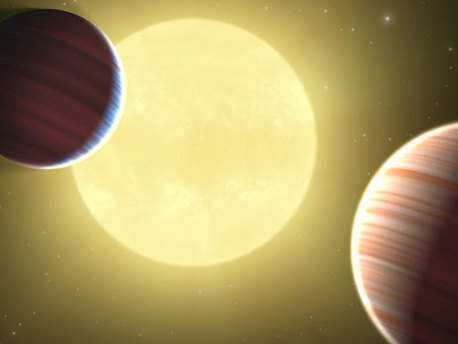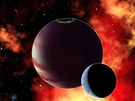NASA's Kepler Mission Discovers
Two Planets Transiting Same Star
 © NASA/Ames/JPL-Caltech
|
This artist's concept illustrates the two Saturn-sized planets discovered by NASA’s Kepler mission. The star system is oriented edge-on, as seen by Kepler, such that both planets cross in front, or transit, their star, named Kepler-9. This is the first star system found to have multiple transiting planets.
Kepler's ultra-precise camera measures tiny decreases in stars' brightness that occur when a planet transits them. The size of the planet can be derived from these temporary dips.
The distance of the planet from a star can be calculated by measuring the time between successive dips as the planet orbits the star. Small variations in the regularity of these dips can be used to determine the masses of planets and detect other non-transiting planets in the system.
In June 2010, Kepler mission scientists submitted findings for peer review that identified more than 700 planet candidates in the first 43 days of Kepler data. The data included five additional candidate systems that appear to exhibit more than one transiting planet. The Kepler team recently identified a sixth target exhibiting multiple transits and accumulated enough followup data to confirm this multi-planet system.
"Kepler's high-quality data and round-the-clock coverage of transiting objects enable a whole host of unique measurements to be made of the parent stars and their planetary systems," said Doug Hudgins, the Kepler program scientist at NASA Headquarters in Washington.
Scientists refined the estimates of the masses of the planets using observations from the W.M. Keck Observatory in Hawaii. The observations show Kepler-9b is the larger of the two planets, and both have masses similar to but less than Saturn. Kepler-9b lies closest to the star, with an orbit of about 19 days, while Kepler-9c has an orbit of about 38 days. By observing several transits by each planet over the seven months of data, the time between successive transits could be analyzed.
"This discovery is the first clear detection of significant changes in the intervals from one planetary transit to the next, what we call transit timing variations," said Matthew Holman, a Kepler mission scientist from the Harvard-Smithsonian Center for Astrophysics in Cambridge, Mass. "This is evidence of the gravitational interaction between the two planets as seen by the Kepler spacecraft."
In addition to the two confirmed giant planets, Kepler scientists also have identified what appears to be a third, much smaller transit signature in the observations of Kepler-9. That signature is consistent with the transits of a super-Earth-sized planet about 1.5 times the radius of Earth in a scorching, near-sun 1.6 day-orbit. Additional observations are required to determine whether this signal is indeed a planet or an astronomical phenomenon that mimics the appearance of a transit.
Source: NASA
NASA's Kepler Mission Discovers
Two Planets Transiting Same Star
 © NASA/Ames/JPL-Caltech
|
This artist's concept illustrates the two Saturn-sized planets discovered by NASA’s Kepler mission. The star system is oriented edge-on, as seen by Kepler, such that both planets cross in front, or transit, their star, named Kepler-9. This is the first star system found to have multiple transiting planets.
Kepler's ultra-precise camera measures tiny decreases in stars' brightness that occur when a planet transits them. The size of the planet can be derived from these temporary dips.
The distance of the planet from a star can be calculated by measuring the time between successive dips as the planet orbits the star. Small variations in the regularity of these dips can be used to determine the masses of planets and detect other non-transiting planets in the system.
In June 2010, Kepler mission scientists submitted findings for peer review that identified more than 700 planet candidates in the first 43 days of Kepler data. The data included five additional candidate systems that appear to exhibit more than one transiting planet. The Kepler team recently identified a sixth target exhibiting multiple transits and accumulated enough followup data to confirm this multi-planet system.
"Kepler's high-quality data and round-the-clock coverage of transiting objects enable a whole host of unique measurements to be made of the parent stars and their planetary systems," said Doug Hudgins, the Kepler program scientist at NASA Headquarters in Washington.
Scientists refined the estimates of the masses of the planets using observations from the W.M. Keck Observatory in Hawaii. The observations show Kepler-9b is the larger of the two planets, and both have masses similar to but less than Saturn. Kepler-9b lies closest to the star, with an orbit of about 19 days, while Kepler-9c has an orbit of about 38 days. By observing several transits by each planet over the seven months of data, the time between successive transits could be analyzed.
"This discovery is the first clear detection of significant changes in the intervals from one planetary transit to the next, what we call transit timing variations," said Matthew Holman, a Kepler mission scientist from the Harvard-Smithsonian Center for Astrophysics in Cambridge, Mass. "This is evidence of the gravitational interaction between the two planets as seen by the Kepler spacecraft."
In addition to the two confirmed giant planets, Kepler scientists also have identified what appears to be a third, much smaller transit signature in the observations of Kepler-9. That signature is consistent with the transits of a super-Earth-sized planet about 1.5 times the radius of Earth in a scorching, near-sun 1.6 day-orbit. Additional observations are required to determine whether this signal is indeed a planet or an astronomical phenomenon that mimics the appearance of a transit.
Source: NASA







